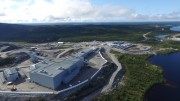Last week we highlighted the shocking collapse in iron-ore prices in September, with spot prices down more than 40% for the year, and trading below US$80 per tonne in China — the world’s largest importer — and gave a heads-up to look out for the corporate consequences in the months ahead.
Well, the corporate jockeying came bigger and faster than many could have imagined, with media reports that multi-commodity giant Glencore was interested in acquiring iron ore-dependent supergiant Rio Tinto, which has seen its share price decline 15% in the last couple of months, in tandem with iron-ore prices. The scale of such an acquisition harkens back to mining’s M&A mania in the mid-2000s.
If such a merger went through, the combined entity would have a US$160-billion market cap using today’s valuations, putting it ahead of BHP Billiton’s current US$150-billion valuation, and handing the crown of “World’s Largest Mining Company” to Glencore. It would also give better cover for the merged entity to unload Rio Tinto’s pricey US$20-billion Simandou iron-ore project in Guinea and its politically troublesome Oyu Tolgoi copper-gold mine in Mongolia.
However, Rio Tinto responded that “no discussions are taking place with Glencore,” and that Glencore had contacted Rio Tinto regarding a potential merger in July 2014. The Rio board, after consulting with its financial and legal advisers, “concluded unanimously that a combination was not in the best interests of Rio Tinto’s shareholders. The board’s rejection was communicated to Glencore in early August and there has been no further contact between the companies on this matter.”
Rio Tinto’s ADRs in New York shot up 10% after the rumour surfaced, and have settled up 5%. At the same time, though, under the U.K.’s investment rules, Glencore would now be prevented from bidding for Rio Tinto for six months.
Glencore then responded that “it is no longer actively considering any possible merger transaction with, or offer for the shares of, Rio Tinto … Glencore however reserves its rights to make an offer in the future with the consent of the (U.K. takeover regulators), either with the recommendation of the board of Rio Tinto, in the event of a third-party offer for Rio Tinto or in the event of a material change in circumstances.”
Anglo American — another heavily iron-ore dependent supermajor with a newly depressed share price — also saw its share price jump in as similar manner to Rio Tinto’s, as investors bet that it might be a better fit for Glencore.
• The Glencore approach to Rio Tinto is emblematic of a return to larger and higher-quality M&A deals in the second half of 2014, along with Freeport-McMoRan selling its Candelaria copper-mining complex in Chile to Lundin Mining for US$1.8 billion. Other large deals on the table of late have included BHP Billiton’s “Newco” spin-out, the now-abandoned asset split by AngloGold Ashanti, and Iamgold’s US$500 million sale of its cash cow Niobec niobium mine to a private group led by the ex-CEO of Barrick Gold Aaron Regent.
• An anonymous, handwritten letter passed on to our Vancouver bureau, sent for our “coffee-break amusement,” highlighted an interview in the April 20, 2013, edition of the Globe and Mail, in which Vancouver mining mogul and philanthropist Frank Giustra argued that gold’s 12-year bull run was not over. (At the time gold traded at US$1,430 per oz., and has since steadily declined to today’s US$1,218 per oz.)
The letter-writer then circled this choice quote by Giustra in the article: “If I am wrong, if this gold bull market is over, I will stand in the centre of Robson Square and I will sing Patsy Cline’s ‘So Wrong’ wearing ladies’ underwear.”
The writer closed with a jaunty: “Well, he is wrong . . . see you at the square.”
If this catches on, and gains a philanthropic edge, it may just evolve into the mining-CEO version of the ALS ice-bucket challenge.




Be the first to comment on "Editorial: Glencore backs off run at Rio Tinto, for now"